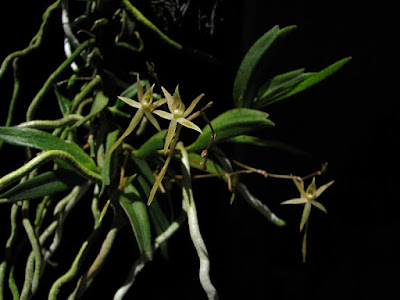Angraecum cultriforme is native to East Africa. The natural habitat of these plants reaches south to Natal in South Africa, and includes Malawi, Mozambique, Zimbabwe, Zambia, Tanzania and Kenya...
Angraecum cultriforme also called as The Knife-Shaped Leaf Angraecum, is a species of the genus Angraecum. This species was described by Victor Samuel Summerhayes in 1958.
IDENTIFY ANGRAECUM CULTRIFORME
Angraecum cultriforme is native to East Africa. The natural habitat of these plants reaches south to Natal in South Africa, and includes Malawi, Mozambique, Zimbabwe, Zambia, Tanzania and Kenya. This orchid is found in damp, evergreen forests and in forests on the coastal dunes. Its habitat is warm coastal areas, but these plants also meet in forest areas covering mountains in Kenya, southern Tanzania and Zimbabwe, where they were found even at heights of 2200 m. The plants usually grow near rivers, often low at the ground on tree trunks, boughs and small branches.
It is a small sized, erect to pendant, hot to warm growing epiphyte, which reaching 8-28 cm in height, with straight to curved, slightly 2 edged stems carrying 2 ranked, ligulate, falcate, very unequally bilobed apically, yellowish to pinkish green, sometimes dotted darker, 2-6 cm long and 0.5-0.8 cm wide leaves.
The Knife-Shaped Leaf Angraecum blooms in the fall and winter on a one per node, sometimes to 4, 2.5 cm long, single flowered inflorescence with lanceolate, acute floral bracts and carrying sometimes non-resupinate flowers. The flowers are small with a diameter of only 1.6 cm, varying from pink to greenish-brown. Sepals are lanceolate, with sharp tips. Upper sepals are straight, lateral sepals sometimes are sickle-shaped and bent so that their tips cross over behind the lip. Petals narrow, lanceolate, arranged horizontally. The lip is oval-lanceolate, strongly concave, with an elongated, sharp tip, raised upwards. The lip has a slightly swollen, straight or slightly curved spur 2.5 cm long.
ANGRAECUM CULTRIFORME CARE AND CULTURE
Cultural information should only be used as a guide, and should be to be adapted to suit you. Your physical location; where you grow your plants, how much time you have to devote to their care, and many other factors, will need to be taken into account. Only then can you decide on the cultural methods that best suit you and your plants.
Light:
Angraecum cultriforme needs a light level of 18000-25000 lux. The light should be filtered and dispersed, and the plants should not be exposed directly to the sun in the afternoon hours. Strong air movement should be ensured all the time.
Temperature:
It is a thermophilic plant. The average temperature in the summer of 25-26 ° C , night 19-20 ° C , a difference of daily 5-7 ° C. In winter, the average daily temperatures are 21-22 ° C and night of 10-12 ° C , with an amplitude daily 9-12 ° C .
Humidity:
The Knife-Shaped Leaf Angraecum needs the average humidity of 75% for most of the year, but drops to 65-70% in 3-4 months in late autumn and early winter.
Substrate, growing media and repotting:
Angraecum cultriforme can be fixed tightly to pieces of tree fern or cork. However, if they are grown so, they should be provided with high humidity, and in the summer they must be irrigated at least once a day. During dry and hot periods it may be necessary to water several times a day.
These plants can also grow in pots or baskets with good drainage, however, due to the need for abundant watering the substrate must be very loose and well-permeable. The roots must dry quickly after watering, so the substrate must never be desiccated or soaked.
Repotting or dividing plants should be done when the growth of new roots begins. This will allow the plant to stabilize in the shortest possible time without exposing it to stress.
Watering:
The cultivated plants should be irrigated abundantly during active growth, but their roots must dry quickly after watering, and the ground around them must never be spread or soggy. In late autumn, watering should be gradually reduced.
Fertilizer:
During the active growth, the plants should be fertilized every week 1/4-1/2 of the recommended dose of fertilizer for orchids. You can use balanced fertilizer throughout the year, but can also use fertilizer with increased nitrogen content from spring to mid summer, and then in the late summer and autumn, use a fertilizer with a higher content of phosphorus.
Rest period:
In winter, Angraecum cultriforme need less water, but those mounted on the bark can not do without water for a long time, and grown in pots can never dry up completely. Fertilization should be reduced or completely eliminated until more intense watering starts in the spring.















COMMENTS